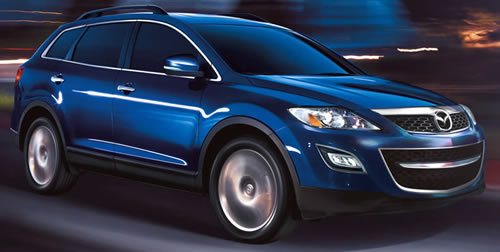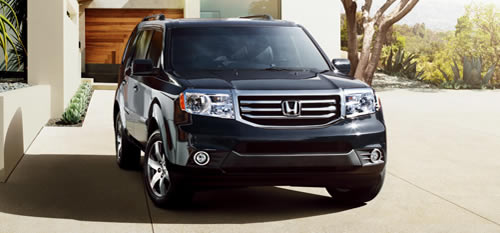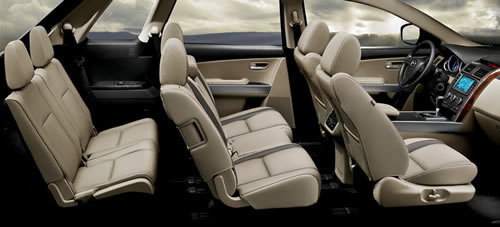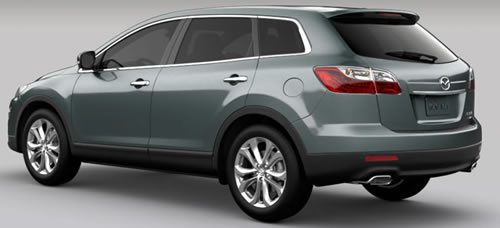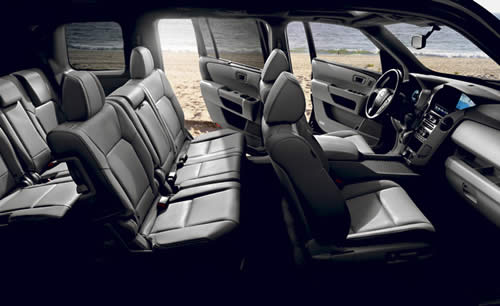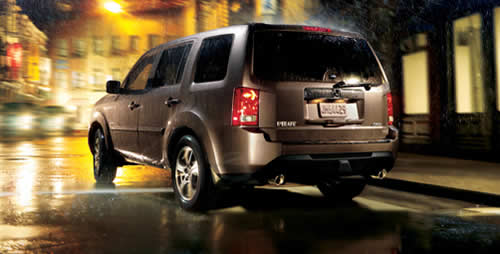|
Mazda CX-9 Meets Honda PilotBy Jim Bray They're both big, three row SUV/Crossovers, from Japan, and both sell for about the same price. But are they mostly the same, or are they two distinct variations on the theme? Clearly, just to look at the two vehicles you can tell it's the latter, that each of these big family haulers is its own man, so to speak. The Mazda comes across as, well, "Zoom-Zoom," but it's also more stylish than the rather boxy Pilot – not that beauty is anything other than in the eye of the beholder, of course. The Honda appears clearly as more utility-oriented than the CX-9, with nifty storage areas throughout and a much more "workman-like" mien. Yet they have so much in common, right down to their "as tested" prices of just over $48,000 Canadian ($48,270 for the Mazda versus $48,520 for the Honda). Both also feature V6 engines that put out at least 250 horses, each has an independent MacPherson strut-type front suspension and a multi-link rear, all wheel drive and, in the higher end trim levels Mazda Canada and Honda Canada provided for the sample vehicles, are loaded with just about anything you can imagine, including a fold down LCD screen and DVD player so rear seat passengers can veg out with a flick or a game rather than resort to bored fisticuffs – unless it's over the choice of which DVD to watch! And they're both terrific vehicles. Zoom, with a view… The Mazda CX-9 GT which, like the Pilot, has a marvelous greenhouse, gets its motivation from a 3.7 liter DOHC V6 engine that "Zoom-Zooms" 273 horses onto the road (with 270 lb.-ft. of torque). That's plenty to get this large hauler hauling briskly. The power gets to the four wheels via "active torque split," which is standard on the upscale GT, and a six speed automatic transmission with overdrive and a manual sport mode that lets you shift the vehicle yourself.
That's more enjoyable than the Pilot's five speed automatic, which offers no manual setting at all – further giving the impression more of utility than sport. Honda does offer variable cylinder management for its 3.5 liter DOHC V6, however, an engine that puts 250 horses and 253 ft.-lb. onto the road via its Variable Torque Management 4-wheel drive system. The lower power output and the variable cylinder management undoubtedly helps contribute to the Pilot's better gas mileage – 12.3/8.2 liters per 100 kilometres city/highway versus the CX-9's 12.8/9.0, though Mazdas exhibiting a larger thirst than some of its competition should surprise no one. Nothing in life is free, and if you want "Zoom-Zoom" you should be prepared to pay for it at the pump – though it appears the premium isn't that much if you believe these Canadian government stats. The Mazda's GT trim level gets you 20 inch alloy wheels, a Blind Spot Monitoring System that lights up in the outside rear view mirrors and beeps if you activate the signal lights when the BSM says you shouldn't, which can be annoying. You also get a rear view camera, Xenon (HID) headlights, fog lights, turn signals on the outside mirrors and an intelligent key system that lets you keep the fob in your pocket. Add to the list driver's seat memory an audio display screen, Bluetooth hands-free phone system with music streaming, and a premium, 10 speaker Bose audio system with an in-dash six disc CD changer. The only option on the GT test vehicle was the Navigation package, which includes a voice-activated touch screen, power tailgate, and the rear entertainment system. The interior is modern, clean and luxurious, with easy to read gauges and easy to learn and operate controls. The GT also came with heated leather and lots of room in the first two rows. Getting in and out of the third row is interesting, but the seat itself is surprisingly comfortable. Put three people back there and only two are going to come out, unfortunately – though the same can be said for the Pilot and pretty well any another vehicle in this class. The Mazda has an interesting smart key/keyless entry system. Little black buttons on the outside door handles let you lock and unlock the CX-9 with the key fob in your pocket, but there's no "start/stop" button inside. Rather, the CX-9 starts conventionally, except you just crank a little twisty thing on the steering column instead of using the key. This seemed a bit like an afterthought, but it's actually better than push button start because you can turn off the engine and go to auxiliary mode without having to shut the vehicle all the way off. You also don't need to step on the brake to start the CX-9, unlike most of the push button start/stop vehicles I've driven. Speaking of driving, the CX-9 does very well in that department. Indeed, it feels big (and indeed, it is), but it manages to up the smile-generating component better than many such vehicles – the Pilot, for one. The voice recognition works fine, once you stop overthinking it. I tried saying phone numbers extra slowly and clearly and it screwed up every time. When I tried speaking normally, however, it worked fine. Go figure! Prodigious Pilot… The Honda Pilot Touring looks almost as if Honda wanted to compete with the Hummer (and look where that got GM!). It's boxy, and very utilitiarian-looking compared to the sporty Mazda. Yet it's really just as good a vehicle as the Mazda; they're just two very different ways of approaching the three row SUV/CUV concept. For 2012, the Pilot features a somewhat sleeker front-end and enhanced interior features such as a "more refined" instrument panel and a more intuitive button layout, the latter of which is especially good to see. The boxy theme is repeated inside, with lots of rectangles and not much in the way of artsy swoopiness like that found in the CX-9. It's full of storage bins, including a really great one on the center console where most vehicles have the gear lever. Honda moved the gear lever up onto the dashboard, where it's still nicely at hand (though a tad awkward). That leaves a big squarish storage bin on the console, with a sliding and latching top that's big enough to hold my iPad very nicely if I want to leave it there unseen.
The Touring version comes loaded to the gunwales, too, from an easy to pair Bluetooth HandsFreeLink connection for phone and tunes, Honda's Satellite-Linked Navigation System (with trilingual Voice Recognition, which should make for some interesting opportunities for those who enjoy trying to confuse the robotic brain). Naturally, there's a rear view camera and front and rear parking sensors. The audio system is a very good 650-watt AM/FM/CD Premium system with 10 speakers, including a subwoofer and 5.1 Surround Sound Theatre Mode. It doesn't play DVD-Audio discs in their native MLP format (it plays them as Dolby Digital 5.1 instead, which is okay), but neither does most of the competition. The Pilot feels even bigger than the CX-9 to drive – and to park – but it handles well enough and, though it doesn't pull as nicely as the Mazda, it's more than up to the task of getting you up to speed. The suspension features MacPherson struts up front with a multilink rear and, in keeping with the utility theme, there's a trailer hitch integrated into the Pilot's posterior. Honda says the Pilot will pull 4500 pounds. Honda's interfaces are kind of annoying. You have to click through a "lawyer's screen" before you can get at the LCD (otherwise it just displays the time after a while), at which time it defaults to the map. Then, if you bring up the audio screen to listen to the radio, it reads out the station's ID. This is undoubtedly meant to help blind drivers choose the right music. The interior is comfortable and reasonably luxurious, and the third row seat is as tolerable as any. And unlike my experience with the Mazda, I didn't nearly do a face plant getting out of the steerage section – though may have been more a case of operator oafishness than a Mazda design flaw, however. So which is better? That's a tough one. Since these vehicles seem aimed a very different people, and they're almost similar in price, capabilities and comforts, each can claim the title legitimately. I could live with either, easily, but if push came to shove I'd take the Mazda's more luxurious feel, coolness and drivability over the Honda's utility and, as the company says, "highest fuel economy available in a three-row, eight-passenger SUV." But I might sneak over to a Honda dealer late at night, rip that iPad storage bin out of the Pilot and cram it into the CX-9. Copyright 2012 Jim Bray Jim Bray is a member of the Automobile Journalists Association of Canada. His columns are available through the TechnoFile Syndicate.
We welcome your comments! |
|
|||||||||||||
